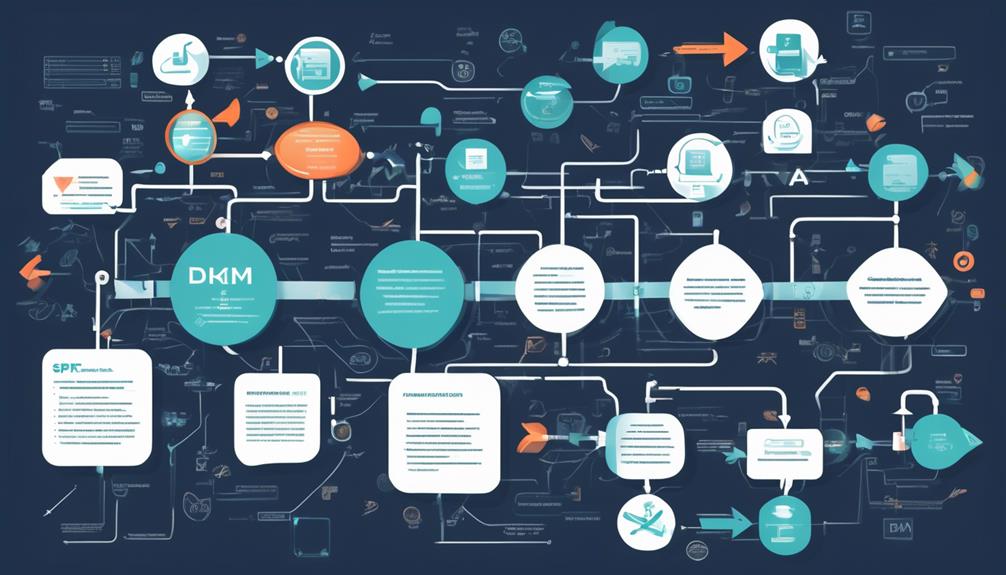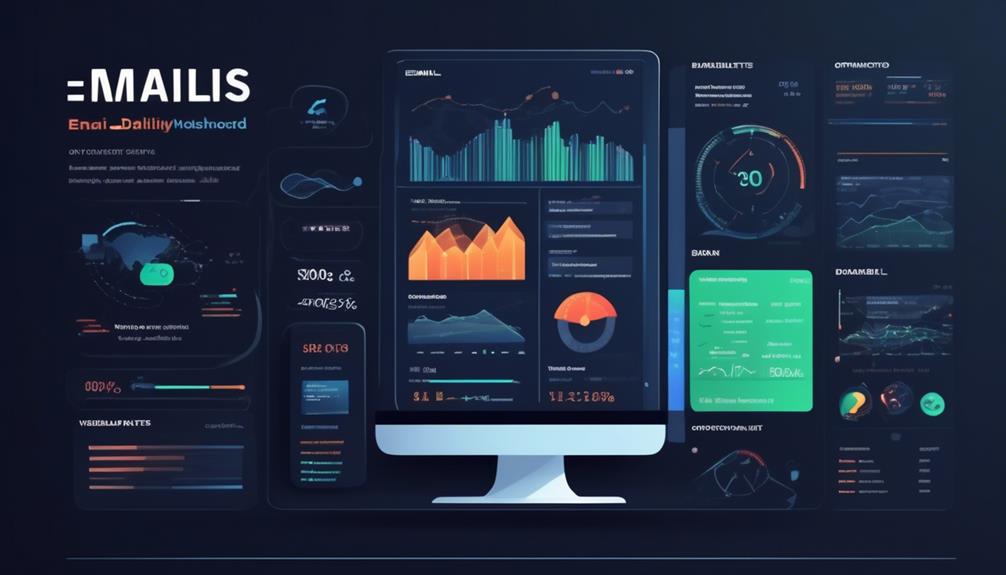We’ve all been there – crafting an email thoughtfully, only to find out it didn’t reach the recipient’s inbox. Did you know that around 20% of legitimate emails fail to reach their target? This is a frustrating problem for many businesses and individuals.
But fear not, because there are concrete steps we can take to ensure our emails have the best chance of reaching their destination. From understanding email deliverability to crafting engaging content and addressing potential pitfalls, the solutions are within reach.
Let's explore the intricacies of email deliverability and discover practical strategies to overcome these challenges.
Key Takeaways
- Implementing a double opt-in process can reduce the likelihood of spam complaints and improve email deliverability.
- Maintaining a positive sender reputation by using legitimate domain names and email addresses is crucial for ensuring emails reach the intended recipients' inboxes.
- Validating email addresses through email validation tools reduces bounce rates and improves email deliverability.
- Crafting engaging email content with compelling subject lines, visual content, and personalized messages helps avoid being marked as spam and increases open rates.
Understanding Email Deliverability
Understanding email deliverability is crucial for ensuring that your emails reach their intended recipients' inboxes and avoid being flagged as spam. Email deliverability refers to the ability of an email to successfully reach the recipient's inbox. It encompasses various factors such as authentication, reputation, and content.
High spam complaint rates can negatively impact email deliverability, leading to emails being filtered into spam folders or even blocked by Internet Service Providers (ISPs). To mitigate spam complaints, it's essential to send relevant and anticipated content to subscribers. Additionally, implementing a double opt-in process can help ensure that subscribers genuinely want to receive your emails, reducing the likelihood of spam complaints.
Furthermore, authentic domain names play a critical role in building a credible email reputation, thus preventing ISPs from blocking emails. By understanding these key aspects of email deliverability and taking proactive measures to address spam complaints, businesses can enhance their email deliverability, ensuring that their messages reach the intended recipients' inboxes.
Importance of Sender Reputation

Developing a strong sender reputation is essential for achieving optimal email deliverability. Maintaining a positive sender reputation ensures that your emails aren't flagged by spam filters and reach the intended recipients' inboxes. To achieve this, consider the following:
- Authenticity: Using legitimate domain names and email addresses is crucial for building a credible sender reputation.
- URL Shorteners: Avoiding URL shorteners in emails can prevent ISPs from flagging your emails, thereby preserving your sender reputation.
- Image-to-Text Ratio: Maintaining a balanced image-to-text ratio in your emails can positively impact your sender reputation and prevent filtering by ISPs.
- Double Opt-In: Implementing a double opt-in process for subscribers can contribute to establishing a trustworthy sender reputation.
Validating Email Addresses
Validating email addresses is an essential step in ensuring the accuracy and deliverability of your email communications. By validating email addresses, you can verify that they're correctly formatted and exist, reducing bounce rates and improving email deliverability. This process also aids in identifying and removing invalid or fake email addresses from your list.
Proper email validation is crucial as it can prevent spam complaints and protect your sender reputation. When invalid email addresses are present in your mailing list, it can result in your emails being marked as spam, leading to decreased deliverability and potential damage to your sender reputation.
To streamline this process, utilizing email validation tools can automate the verification process, saving time and effort. By incorporating email validation into your email marketing practices, you can enhance the accuracy of your recipient list, minimize the risk of spam complaints, and ultimately improve the deliverability of your emails.
Crafting Engaging Email Content

When crafting engaging email content, we focus on three key points: compelling subject lines, impactful visual content, and personalized message content.
Compelling subject lines are essential for making a positive first impression and increasing open rates.
Visual content can enhance engagement, while personalized messages help avoid being marked as spam and foster a stronger connection with recipients.
Compelling Subject Lines
Crafting compelling and concise subject lines is essential for capturing recipients' attention in email marketing campaigns. When crafting subject lines for emails, it's important to avoid all-caps, excessive punctuation, and special characters to prevent being marked as spam.
Personalizing subject lines and tailoring them to specific interests and needs can significantly increase engagement. It's crucial to use attention-grabbing techniques while steering clear of spam trigger words and misleading statements in subject lines.
Additionally, optimizing subject lines involves avoiding over-capitalization, unnecessary punctuation, and excessive use of symbols and special characters. By following these guidelines, marketers can ensure that their emails stand out in recipients' inboxes and are more likely to be opened and engaged with.
Visual Content Impact
To enhance email engagement, incorporating visually appealing graphics and videos is essential. Visual content is a powerful tool in email marketing to capture the recipient's attention and increase open rates. Including eye-catching elements such as infographics, GIFs, and interactive content can make emails more engaging and impactful.
Visuals can convey information more effectively than plain text, making the message easier to understand and more memorable for the recipient. It's crucial to optimize visual content for various devices and email clients to ensure a seamless viewing experience.
Personalized Message Content
Implementing personalized message content is essential for crafting engaging and impactful email marketing campaigns. When creating personalized email content, it's crucial to cater to individual interests and preferences. Craft compelling subject lines that pique recipients' interest, increasing the likelihood of email opens.
Tailoring email content to meet specific audience needs and consistently provide value enhances engagement. Implement personalized marketing strategies to ensure that the emails resonate with recipients, increasing relevance and interest.
By creating targeted content based on audience preferences, you can significantly enhance the impact of your email marketing efforts.
- Cater to individual interests and preferences.
- Craft compelling subject lines.
- Tailor email content to meet specific audience needs.
- Implement personalized marketing strategies.
Avoiding Spam Traps

When it comes to email deliverability, avoiding spam traps is crucial for maintaining a positive sender reputation.
Identifying and implementing prevention strategies is essential to minimize the risk of hitting spam traps.
Spam Trap Identification
By regularly scrubbing our email lists and utilizing email verification tools, we can proactively identify and avoid spam traps, thereby improving our email deliverability.
To effectively identify and avoid spam traps, we need to implement the following strategies:
- Use authentic domain names to build credibility and avoid being marked as spam.
- Avoid using URL shorteners, as they may trigger spam filters.
- Maintain a balanced image-to-text ratio in emails to prevent triggering spam filters.
- Implement email authentication methods like SPF and DKIM to confirm the sender's identity and protect against spoofing and phishing attacks.
Prevention Strategies
To prevent falling into spam traps, it's crucial to carefully choose and use domain names that establish credibility and to refrain from employing URL shorteners that may trigger spam filters. Using free domain email addresses can lead to emails being blocked or marked as spam.
Therefore, it's important to utilize authentic domain names to build a credible email reputation and avoid being flagged as spam.
Additionally, caution should be exercised with URL shorteners, as they can be viewed as potential spam risks by ISPs. To mitigate this risk, hyperlink long URLs in emails instead of using URL shorteners.
It's also advisable to limit the volume of images in emails as an excessive number of images can lead to emails being flagged as spam by ISPs.
Implementing SPF, DKIM, and DMARC

Implementing SPF, DKIM, and DMARC enhances email deliverability and safeguards against domain spoofing and unauthorized use. These email authentication practices are crucial for ensuring that your emails are successfully delivered to recipients' inboxes and for protecting your domain from abuse.
- SPF (Sender Policy Framework): Verifies the sender's IP address to prevent domain spoofing.
- DKIM (DomainKeys Identified Mail): Provides a digital signature verifying the message came from the sender's domain.
- DMARC (Domain-based Message Authentication, Reporting, and Conformance): Monitors email authentication, providing visibility and control over messages sent using your domain name.
- Protection Against Spoofing and Unauthorized Use: Properly implementing SPF, DKIM, and DMARC can protect against spoofing, phishing attacks, and unauthorized use of your domain.
Monitoring Email Engagement Metrics

Let's talk about the important email engagement metrics that we need to monitor for a successful email deliverability strategy.
Open rates, click-through rates, and unsubscribe rates are crucial indicators of how recipients are interacting with our emails.
Email Open Rates
Monitoring email open rates provides valuable insights into the effectiveness of our email campaigns. This enables us to identify engaging content and make targeted improvements for enhanced engagement and conversions.
Reasons for monitoring email open rates include:
- Evaluating the effectiveness of subject lines.
- Identifying engaging content that resonates with recipients.
- Allowing for targeted improvements in email content and delivery strategies.
- Highlighting potential deliverability issues or the need for better personalization and segmentation.
Regularly analyzing open rates helps optimize email marketing efforts, leading to improved engagement and conversions. By focusing on subject lines and content that drive higher open rates, we can enhance the overall performance of our email campaigns.
Click-Through Rates
To gauge recipient engagement and assess the effectiveness of our email content and subject lines, we rely on monitoring Click-Through Rates (CTR), which measure the percentage of recipients who click on email links. Analyzing CTR helps us understand how well our email campaigns are performing in driving recipient actions. Below is a table summarizing reasons behind low CTR and solutions to improve it:
| Reasons Behind Low CTR | Solutions |
|---|---|
| Irrelevant content | Personalize content |
| Unclear call-to-action | Use compelling CTAs |
| Poor link placement | Optimize link positioning |
| Ineffective subject lines | A/B test different options |
| Misaligned audience | Segment and tailor emails |
Unsubscribe Rates
Tracking unsubscribe rates provides valuable insights into recipient engagement and aids in refining our email marketing tactics and content. High unsubscribe rates indicate disinterest or dissatisfaction with the email content, making it essential to monitor and address these metrics.
To effectively manage unsubscribe rates, we can employ the following strategies:
- Regularly review unsubscribe rates and compare them with industry benchmarks to identify areas for improvement.
- Analyze the reasons behind unsubscribes to understand recipient preferences and tailor content accordingly.
- Implement a preference center to allow recipients to manage the frequency and type of emails they receive.
- Continuously test different email content and strategies to gauge their impact on reducing unsubscribe rates.
Managing Bounce Rates Effectively

Effectively managing bounce rates is essential for maintaining a healthy email deliverability and ensuring that messages reach their intended recipients. One effective strategy for managing bounce rates is to regularly update and verify email lists, removing invalid or inactive addresses. Additionally, using authentic domain names instead of free domain email addresses can build credibility and reduce the likelihood of being marked as spam.
Another crucial aspect of managing bounce rates effectively is to balance the ratio of images to text in emails. Excessive use of images can trigger spam filters, leading to higher bounce rates. Implementing a double opt-in process can also help reduce bounce rates by authenticating legitimate subscribers and minimizing the influence of spam bots.
It's important to monitor email deliverability and inbox placement to identify and address issues impacting email reach. This proactive approach allows for swift resolution of any problems affecting bounce rates.
Moreover, avoiding the use of special characters in email subject lines and content can also contribute to reducing bounce rates. By following these best practices, email senders can effectively manage bounce rates and improve overall deliverability.
Building and Maintaining a Quality Email List

Building and maintaining a quality email list is essential for maximizing email deliverability and engagement with recipients. To achieve this, we recommend the following:
- Use authentic domain names: Using authentic domain names in your email marketing helps build credibility and reduces the likelihood of being marked as spam by email filters.
- Implement double opt-in: By utilizing double opt-in methods, you can reduce the risk of spam bots infiltrating your contact list, thus maintaining a credible email reputation.
- Ensure balanced email content: Maintaining a balanced ratio of 40% images and 60% text in your emails helps avoid triggering spam filters, enhancing the chances of your emails reaching recipients' inboxes.
- Regularly clean and update email lists: Periodically cleaning and updating your email lists is crucial for maintaining a quality contact list. Additionally, segmenting the lists based on user behavior and preferences can significantly improve engagement and overall email marketing performance.
Establishing Clear Permission-Based Practices

When establishing clear permission-based practices, it's crucial to implement a transparent opt-in process that ensures explicit consent from subscribers.
This helps to build trust and credibility, ultimately reducing the risk of being marked as spam.
Clear Opt-In Process
To establish clear permission-based practices for email marketing, it's essential to clearly outline the opt-in process for subscribers to provide explicit consent to receive emails. Implementing a clear opt-in process involves the following best practices:
- Use clear subject lines in the opt-in email to ensure subscribers understand the purpose of the communication.
- Employ double opt-in to confirm subscriber consent, reducing the risk of spam bots and incorrect sign-ups.
- Communicate the frequency and type of emails subscribers can expect to receive upon opt-in, setting clear expectations.
- Provide a transparent way for subscribers to opt-out of receiving emails in the future, ensuring respect for their preferences.
Explicit Consent Gathering
Gathering explicit consent is crucial for establishing clear permission-based practices in email marketing. By obtaining explicit consent, we ensure that recipients have willingly opted in to receive our emails, reducing the risk of being marked as spam. Implementing a double opt-in process, where subscribers confirm their subscription, is an effective way to establish clear permission-based practices. Clearly stating the type and frequency of emails subscribers will receive is essential for obtaining explicit consent for communication. Regularly updating and maintaining email lists, by removing inactive or unengaged contacts, is vital to ensure explicit consent and engagement. Communicating privacy and data usage policies clearly builds trust and obtains explicit consent from subscribers. Below are some reasons for poor email deliverability and solutions to address them:
| Reasons for Poor Email Deliverability | Solutions |
|---|---|
| Lack of Explicit Consent | Implement double opt-in process |
| Outdated Email Lists | Regularly update and maintain lists |
| Unclear Communication of Policies | Clearly communicate privacy and data usage policies |
Addressing Email Frequency and Consistency

Consistently sending emails at regular intervals helps maintain recipient engagement and prevents emails from being marked as spam due to irregular activity. Crafting the perfect email frequency and consistency strategy is crucial for optimizing deliverability and ensuring that your emails reach the intended inboxes.
Here are some reasons your emails mightn't be reaching inboxes and solutions for addressing email frequency and consistency:
- Avoiding Sudden Spikes: Sudden spikes in email frequency can trigger spam filters and raise suspicion with Internet Service Providers (ISPs).
- Building Trust: Adhering to a consistent email schedule helps build trust with recipients and improves overall email deliverability.
- Monitoring Engagement Metrics: Monitoring email engagement metrics and adjusting frequency based on recipient behavior can optimize email delivery and avoid spam filters.
- Setting Clear Expectations: Setting clear expectations with subscribers about the frequency of emails they can expect prevents surprise and potential spam complaints.
Utilizing Email Testing and Optimization

When implementing email testing and optimization, it's essential to conduct thorough email address and domain authentication to prevent being blocked or marked as spam. By utilizing email testing tools, we can ensure that our emails are reaching the intended inboxes and not being flagged as spam. Optimization involves fine-tuning various elements such as subject lines, email content, and deliverability monitoring to maximize the chances of successful inbox placement.
Email testing allows us to gauge the effectiveness of our email campaigns by analyzing metrics such as open rates, click-through rates, and conversion rates. This data provides valuable insights into what resonates with our audience and what may be triggering spam filters. Optimization strategies can include A/B testing subject lines, balancing image-to-text ratios, and refining content to align with subscriber preferences.
Furthermore, sophisticated email service providers offer authentication protocols such as Sender Policy Framework (SPF), DomainKeys Identified Mail (DKIM), and Domain-based Message Authentication, Reporting & Conformance (DMARC) to establish our domain's legitimacy. Implementing these authentication measures helps build a credible email reputation, enhancing deliverability and inbox placement.
Leveraging Feedback Loops

To build on our efforts to ensure email deliverability, we can strategically employ Feedback Loops to gain valuable insights and proactively address recipient engagement and preferences. Leveraging Feedback Loops offers several key benefits:
- Identifying Complaints: Feedback Loops help to identify and address recipient complaints about unwanted emails, allowing us to take prompt action to rectify the issue and reduce the risk of being marked as spam.
- Insights into Engagement: By monitoring and analyzing Feedback Loop data, we can gain valuable insights into recipient engagement. This information can assist in maintaining a positive sender reputation and ensuring good email deliverability.
- Improving List Quality: Feedback Loops provide the opportunity to improve email list quality by facilitating proactive adjustments to email marketing strategies based on recipient preferences and behavior.
- Proactive Adjustments: Implementing Feedback Loops allows for prompt action on recipient feedback, enabling us to make proactive adjustments to our email marketing strategies and ensure that emails are reaching inboxes effectively.
Seeking Professional Deliverability Assistance

Seeking professional deliverability assistance can provide targeted analysis and tailored solutions to address email deliverability challenges. By enlisting the expertise of deliverability specialists, businesses can benefit from a comprehensive approach to optimizing their email deliverability. These experts can conduct in-depth assessments of email sending practices, identify potential issues such as high spam complaints or poor email authentication, and offer strategic recommendations for improvement. Additionally, professional assistance can encompass the implementation of essential authentication methods like SPF, DKIM, and DMARC to bolster email credibility and mitigate the risk of being flagged as spam. Furthermore, deliverability professionals can offer guidance on optimizing email content and subject lines to enhance engagement and ensure that emails are less likely to trigger spam filters. To illustrate, they might recommend using compelling and relevant subject lines that resonate with recipients while avoiding spam-triggering words or phrases. The table below provides an overview of the benefits of seeking professional deliverability assistance.
| Benefits of Professional Deliverability Assistance |
|---|
| Targeted Analysis and Solutions |
| Implementation of Authentication Methods |
| Optimization of Email Content and Subject Lines |
| Ongoing Monitoring and Maintenance Strategies |
Frequently Asked Questions
Why Are My Emails Not Arriving in My Inbox?
We've found that using a free domain email address can lead to emails being blocked or marked as spam. Authentic domain names help recipients recognize you and build a credible email reputation.
ISPs may flag emails with URL shorteners as possible spam risks, so hyperlinking long URLs in emails is an alternative.
Additionally, emails with a high volume of images are often seen as spam by ISPs.
Why Are All My Emails Not in My Inbox?
We've noticed that not all our emails are landing in the inbox. We've taken steps to rectify this, such as using a reputable domain email address, avoiding URL shorteners, and implementing double opt-in.
Regularly analyzing inbox placement has helped us gauge our success. Additionally, we've made sure to clean and update our email lists to minimize unopened rates.
These efforts have significantly improved our email deliverability and inbox placement.
Why Are Some of My Emails Not Going Through?
We understand the frustration of emails not reaching their destination. There are several factors that could be causing this issue.
Authentic domain names and avoiding URL shorteners can help improve email deliverability.
Additionally, reducing the volume of images in emails can prevent them from being flagged as spam.
Why Are None of My Emails Being Delivered?
Why are none of our emails being delivered?
This could be due to several factors, such as authentication issues, spam triggers in the content, or poor sender reputation.
To address this, we'll focus on improving our domain authentication, optimizing content, and monitoring sender reputation.
What Solutions Can I Use to Prevent My Emails from Bouncing and Reaching Inboxes?
To fix email bounce issues and ensure your emails reach inboxes, consider using a reputable email verification service to clean your contact list. Additionally, regularly update your email list, avoid using spam-triggering words, and implement double opt-in for new subscribers. Monitor bounce rates to identify and address any underlying issues.
How Can Improving Email Sender Reputation Help Emails Reach Inboxes?
Improving email sender reputation can greatly enhance email deliverability. Implementing effective strategies to improve sender reputation, such as maintaining a clean email list and engaging with subscribers regularly, can boost trust with email providers and increase the likelihood of emails reaching recipients’ inboxes.
Conclusion
In conclusion, ensuring our emails reach inboxes is crucial for effective communication.
By focusing on sender reputation, email validation, engaging content, and avoiding spam traps, we can improve deliverability.
Consistently testing and optimizing our emails, leveraging feedback loops, and seeking professional assistance when needed are essential steps in resolving deliverability issues.
Let's work together to build a credible email reputation and ensure our messages are reaching their intended recipients.









